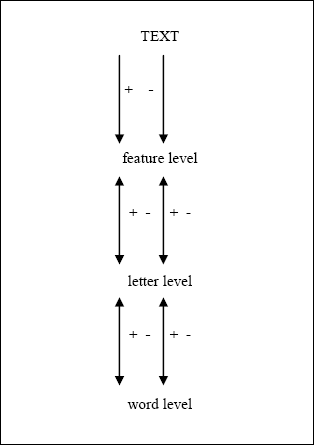
If we really do use a mix of top-down and bottom-up processing, and if we incorporate the excitatory and inhibitory connections we know to exist in the colossal quantities we know they exist in, we have the wiring and procedural requirements for a cascading feature analysis reading model as proposed by Rumelhart and McClelland (1986). They not only proposed this model, but built it into a computer simulation. Their program ‘reads’ a vocabulary of some 1200 words of four letters or less, presented in a simple and consistent script. Within these rather limited parameters the machine reads accurately and swiftly. By altering the text it can be induced to make ‘guesses’ and errors. These are remarkably like those real people make under similar circumstances. Its reading ‘behaviour’ resembles ours. The model seems to be robust and plausible. It has withstood the test of time and the attentions of other investigators well. None of which is proof that we do read this way, of course, but the model is felt, nonetheless, to represent more or less what real life reading is very possibly like. This is how it goes, and how we may also go.
Figure 2.2 is a simplified diagram of their model.
+ denotes an excitatory connection (an on switch)
- denotes an inhibitory connection (an off or dimmer switch)

(Rumelhart and McClelland 1982, as cited in Ellis 1984 and many other texts.)
Figure 2.2 Rumelhart and McClelland's model of word recognition by cascading feature analysis.
This model is, like so many biological processes, complicatedly simple. In other words the constituent parts of the process are simple, the procedures of which it is constructed are simple, but a large number of them may be simultaneously active. Correlate large numbers of simple things appropriately and you may achieve a complex thing. If you can do the simple things simultaneously, you can achieve the complex thing very rapidly, too. Cognitive psychology shows us that this complex coordination of a multitude of simultaneous mini-achievements may ‘simply’ be a result of the wiring - of the patterns of connections between little grey cells or neural nets; ‘simply’ a function of the shape of the circuitry built up over time and as a result of experience and learning. Build the right circuits and the thing is automatic. Learning something is presumed to be the laying down of this circuit, this net of connections, rather than that one. Brave readers may like to consider chaos theory in an attempt to explain the development of mind from matter in this astonishing way. In such case, try Abraham and Gilgen (1995) but first look at one or more of Stewart (1997), Gleik (1987), Cohen and Stewart (1995) or Ford, in Davies (1989).